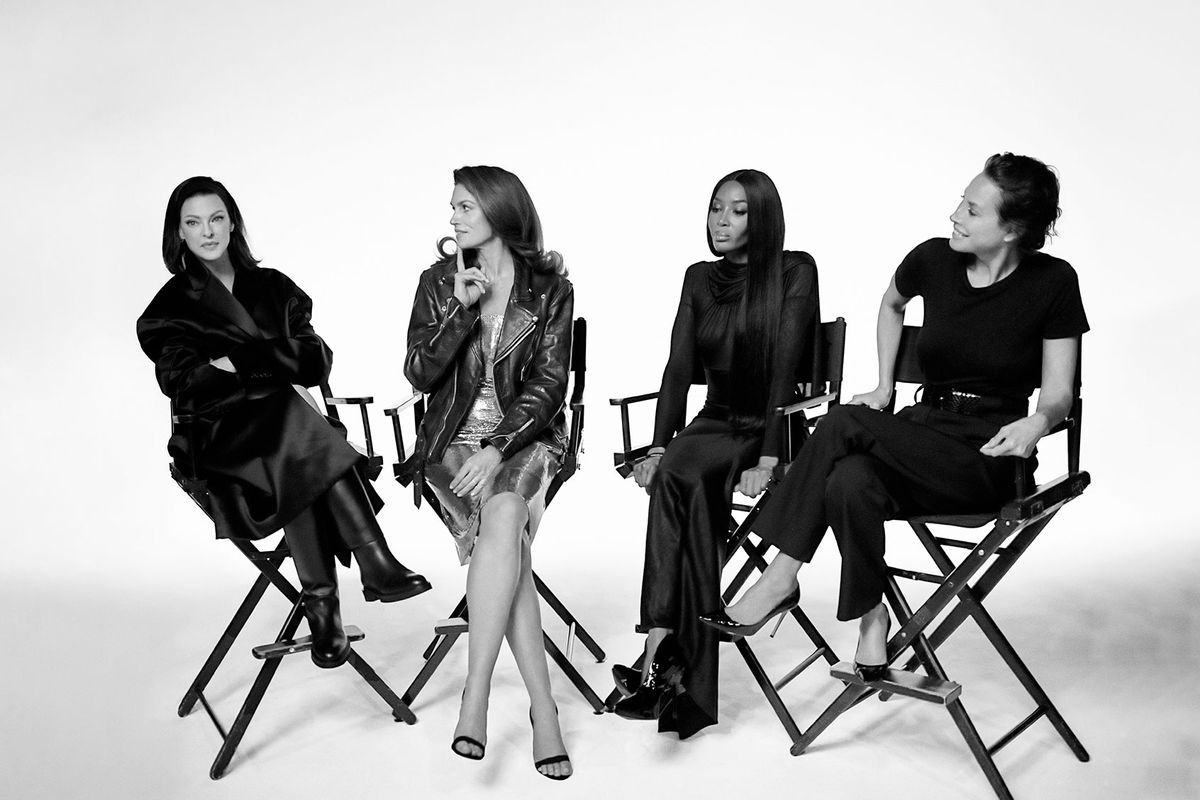Arguably the biggest names in modeling history, Naomi Campbell, Linda Evangelista, Cindy Crawford and Christy Turlington gave definition to the modern-day “supermodel.” They were, after all, the “it girls” of the late-’80s and ’90s. And although their profession and fame were deemed glamorous, they also came with plenty of sacrifices and hardships.
That’s what’s explored in Apple TV+’s latest docuseries “The Super Models,” which shines the spotlight on Campbell, Evangelista, Crawford and Turlington’s journey from their career beginnings to peak stardom. Told in four parts, “The Look,” “The Fame,” “The Power” and “The Legacy,” the series features personal interviews and old footage of its four stars alongside interviews with several fashion experts.
Today, Campbell, Evangelista, Crawford and Turlington remain household names in the cultural sphere. They serve as role models for this generation’s hottest models on the runway — and aspiring models. They are prominent figures within activism, philanthropy and business. And, they’ve taken on new roles in recent years — entrepreneurs, humanitarians and mothers — amid life changes.
Here are the 12 biggest bombshells from the series:
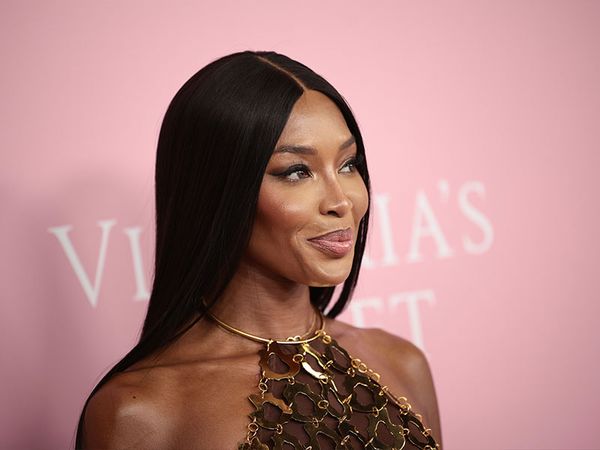 Naomi Campbell attends as Victoria’s Secret Celebrates The Tour ’23 at The Manhattan Center on September 06, 2023 in New York City. (Dimitrios Kambouris/Getty Images for Victoria’s Secret)
Naomi Campbell attends as Victoria’s Secret Celebrates The Tour ’23 at The Manhattan Center on September 06, 2023 in New York City. (Dimitrios Kambouris/Getty Images for Victoria’s Secret)While recalling her childhood, Campbell said she was called the racial slur for the first time when she was just five years of age. Despite the constant bullying she endured while attending private school in London, Campbell said she didn’t let it get to her.
“I wasn’t going to accept being bullied at school for the color of my skin,” she said. “My mother was paying my school fees just like everybody else. I had every right to be there, so take your bullying somewhere else, is how I felt.”
Campbell also spoke about the racism she faced in New York while working as a young model:
“I put out my hands many times on New York City streets, and the taxis would pass by — and then Christy [Turlington] would put out their hands and they would stop,” she said. “The guy would be like, ‘I don’t want to go to Brooklyn,’ and I’m like, ‘I don’t want to go to Brooklyn, why is he saying that?’ It didn’t strike me until Christy would have to stand out in front of me and get me a taxi to get to work.”
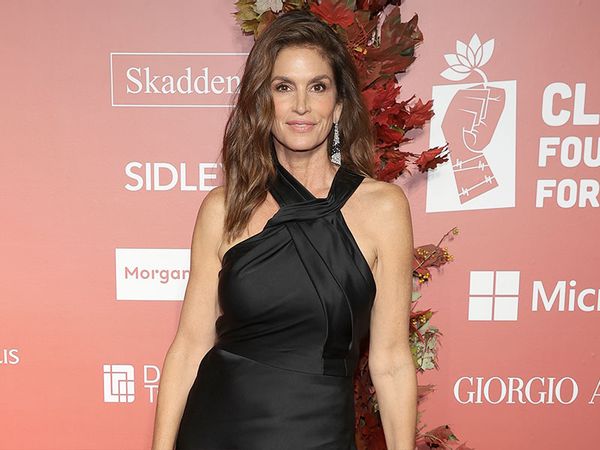 Cindy Crawford attends the Clooney Foundation For Justice Inaugural Albie Awards at New York Public Library on September 29, 2022 in New York City. (Dimitrios Kambouris/Getty Images for Albie Awards)
Cindy Crawford attends the Clooney Foundation For Justice Inaugural Albie Awards at New York Public Library on September 29, 2022 in New York City. (Dimitrios Kambouris/Getty Images for Albie Awards)Crawford reflected on her 1986 appearance on “The Oprah Winfrey Show,” saying Oprah’s treatment of her was “not okay.” In an old clip shown in the documentary, Winfrey is heard asking Crawford, “Did she always have this body? This is unbelievable. Stand up just a moment, now this is what I call a BODY.”
In retrospect, Crawford realized, “I was like the chattel or a child, be seen and not heard.”
“When you look at it through today’s eyes, Oprah’s like, ‘Stand up and show me your body. Show us why you’re worthy of being here,'” she said.
Crawford continued, “In the moment I didn’t recognize it and watching it back I was like, ‘Oh my gosh, that was so not okay really.’ Especially from Oprah.”
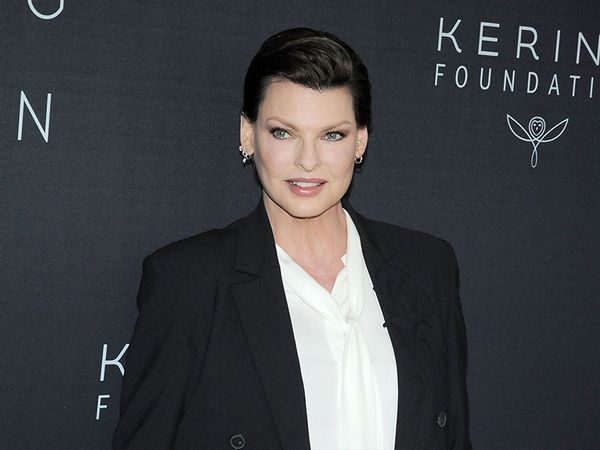 Linda Evangelista attends Kering’s 2nd Annual Caring For Women Dinner – Arrivals at The Pool on September 12, 2023 in New York. (Paul Bruinooge/Patrick McMullan via Getty Images)
Linda Evangelista attends Kering’s 2nd Annual Caring For Women Dinner – Arrivals at The Pool on September 12, 2023 in New York. (Paul Bruinooge/Patrick McMullan via Getty Images)Evangelista’s quote — “I will not get out of bed for less than $10,000 a day” — became one of the most notorious quotes in modeling history after it was published in an interview with Vogue. Today, Evangelista said she doesn’t “want to be known” for the quote.
“I’m not the same person I was 30 years ago. But I just don’t want to be known for that, I don’t want to be known as the model that said that quote,” she said in the documentary. Evangelista apologized, saying, “I shouldn’t have said that. That quote, that quote makes me crazy. I don’t even know how to address it any more.”
Evangelista also claimed the situation would have been different if a man had said it instead: “If a man said it, it’s acceptable. To be proud of what you command.”
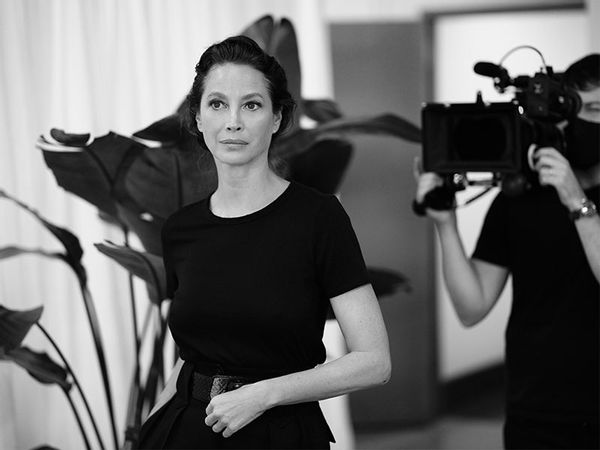 Christy Turlington in “The Super Models” (Photo courtesy of Apple TV+)
Christy Turlington in “The Super Models” (Photo courtesy of Apple TV+)Turlington recalled taking nude photos for the late fashion photographer Patrick Demarchelier during a cover shoot for British Vogue:
“After we finished the shoot we took a portrait. I had these extensions in my hair, so it was this very long hair,” Turlington said. “We did a portrait where I was, like, covering [her hands over her breasts]. The classic covering yourself.”
She continued, saying Demarchelier then asked her, “Can you put your arms down a little bit lower, a little bit lower.”
“I remember being self-conscious, but I didn’t feel necessarily bad. I felt good from that shoot, I felt pretty in that moment,” Turlington added. “Patrick didn’t give me the creeps, per se, but I do remember being like, ‘Oh my gosh, I shouldn’t be doing this.'”
Much to Turlington’s shock, the photo was published on the cover of PHOTO magazine.
“Eventually, that image came out on the cover of PHOTO magazine… it was still like, ‘Oh gosh.’ I don’t know what I thought it was for, but I definitely didn’t think it was for a cover of a magazine,” she said. “I don’t think there was any age that you were supposed to be in order to have a nude picture. I don’t think there was anyone monitoring or regulating any of that.”
In 2018, Demarchelier was accused of sexual harassment by seven models who worked with him. Vogue publisher Condé Nast subsequently announced that they would “not be working with [Demarchelier] for the foreseeable future.”
Demarchelier died on March 31, 2022, at the age of 78.
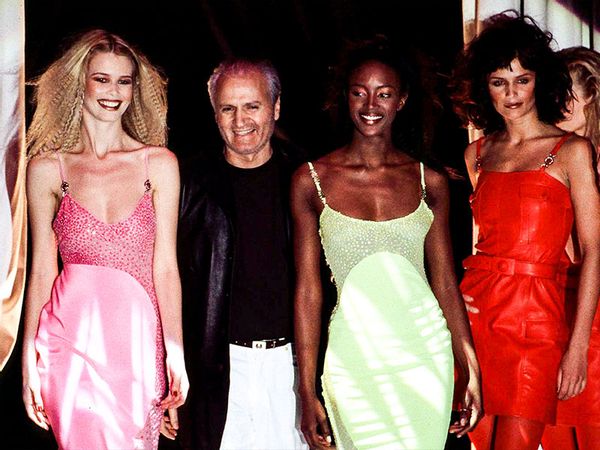 Claudia Schiffer, fashion designer Gianni Versace, Naomi Campbell and Helena Christensen walk the runway during the Versace ready to Wear Fall/Winter 1996-1997 fashion show as part of the Milan Fashion Week on February 26, 1996 in Milan, Italy. (Victor VIRGILE/Gamma-Rapho via Getty Images)
Claudia Schiffer, fashion designer Gianni Versace, Naomi Campbell and Helena Christensen walk the runway during the Versace ready to Wear Fall/Winter 1996-1997 fashion show as part of the Milan Fashion Week on February 26, 1996 in Milan, Italy. (Victor VIRGILE/Gamma-Rapho via Getty Images)Campbell opened up the death of her close friend Gianni Versace and how that immense loss took a toll on her physically, mentally and emotionally:
“When [Gianni Versace] died, my grief became very bad. Grief has been a very strange thing in my life,” Campbell said. “I go into a shock and freak out when it actually happens, and then later is when I break. But I kept the sadness inside, I just dealt with it.”
She continued, “When I started using, that was one of the things I tried to cover up. Grief. Addiction is such a bullshit thing. It really is. You think it’s going to heal that wound. It doesn’t — it can cause such huge fear and anxiety. So I got really angry.
“I was killing myself,” she said. “For my mistakes, I’ve always owned up to them. I chose to go to rehab, it was one of the best and only things I could have done for myself at that time.”
Campbell added that although she’s worked on quitting her addiction for years, “it does still come up sometimes.”
“I just have the tools to deal with it now, when it comes up.”
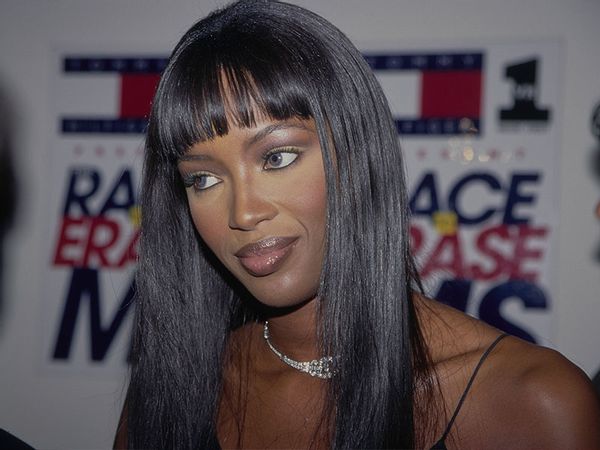 British fashion model Naomi Campbell attends the 5th Annual Race To Erase MS Gala, held at the Century Plaza Hotel in Los Angeles, California, 14th November 1997. (Vinnie Zuffante/Michael Ochs Archives/Getty Images)
British fashion model Naomi Campbell attends the 5th Annual Race To Erase MS Gala, held at the Century Plaza Hotel in Los Angeles, California, 14th November 1997. (Vinnie Zuffante/Michael Ochs Archives/Getty Images)Campbell opened up about the time John Casablancas — the modeling agent, scout and founder of Elite Model Management — called her “difficult” because she refused to sign a year-long contract with Revlon due to an insufficient salary.
“John got very embarrassed and then decided to call me difficult,” she said. “And he then decided he was going to go to the press and say I was difficult and that he fired me.”
Campbell continued, “I’ve heard crazy, I’ve heard nightmare, I’ve heard difficult. I was called difficult because I opened my mouth, period.”
Elsewhere in the documentary, Campbell said, “It was hard to be an outspoken Black woman and I definitely got the cane for it, many times.”
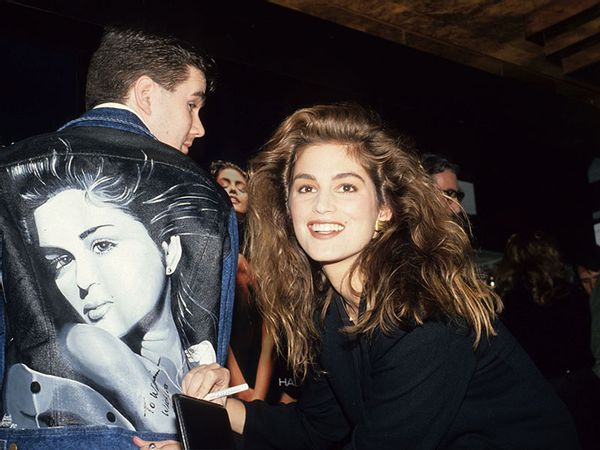 Cindy Crawford during Cindy Crawford Promotes Her Fragrance “Halston” at Bloomingdale’s in New York City – February 26, 1990 at Bloomingdale’s in New York City, New York, United States. (Rose Hartman/WireImage/Getty Images)
Cindy Crawford during Cindy Crawford Promotes Her Fragrance “Halston” at Bloomingdale’s in New York City – February 26, 1990 at Bloomingdale’s in New York City, New York, United States. (Rose Hartman/WireImage/Getty Images)“My dad really didn’t understand that modeling was a real career. He thought modeling was like another name for prostitution,” Crawford said. “So [my parents] came with me to my very first modeling appointment.
“I never even thought about modeling. I didn’t even know it was a real job. I didn’t know how I would get from DeKalb, Illinois, to a magazine.”
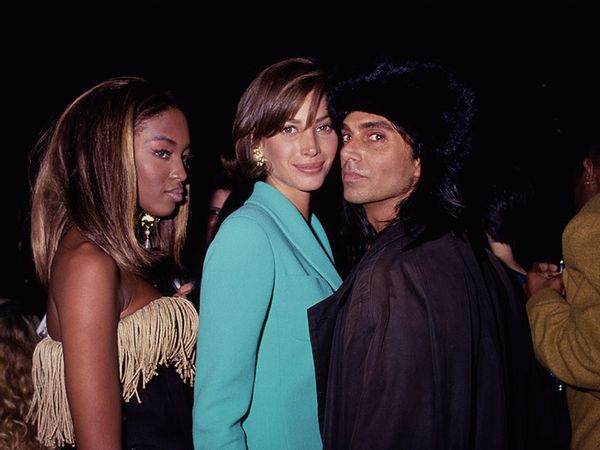 America fashion model Christy Turlington, British fashion model Naomi Campbell, and America photographer Steven Meisel attend the party to celebrate Herb Ritts’ birthday, in Los Angeles, California, 18th November 1990. (Vinnie Zuffante/Michael Ochs Archives/Getty Images)
America fashion model Christy Turlington, British fashion model Naomi Campbell, and America photographer Steven Meisel attend the party to celebrate Herb Ritts’ birthday, in Los Angeles, California, 18th November 1990. (Vinnie Zuffante/Michael Ochs Archives/Getty Images)“I met Jean-Luc Brunel, who was the infamous French agent who was running Karin’s [modeling] agency in Paris at that time,” Turlington said. “And they were like partners, Ford’s and Karin’s. I would go to Paris, and the Fords would have it set up so that I would stay at Jean-Luc’s apartment.”
Brunel, was accused of rape, grooming and partaking in the alleged sex-trafficking ring run by convicted sex offender Jeffrey Epstein. In 2022, Brunel was found dead in his jail cell prior to the start of his trial.
“Nothing happened, most of the time he wasn’t even really there. I got angry just looking back, and thinking like survival skills, like guilt, I can’t believe I’m ok,” Turlington continued. “Nothing really surprises me about anybody. I feel like even people you know, you just don’t know what they’re capable of.”
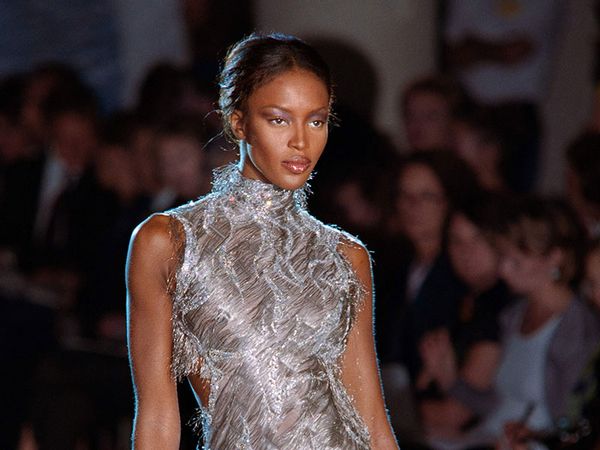 British model Naomi Campbell exhibits a silver thread mesh dress adorned with Swarovski crystals on July 18, 1998 during the Donatella Versace fall/winter 1998/99 haute couture collection in Paris. (THOMAS COEX/AFP via Getty Images)
British model Naomi Campbell exhibits a silver thread mesh dress adorned with Swarovski crystals on July 18, 1998 during the Donatella Versace fall/winter 1998/99 haute couture collection in Paris. (THOMAS COEX/AFP via Getty Images)Campbell said that while working as a young model, she attended a photoshoot where an art director touched her breasts without her consent.
“Once an art director felt the need to tell me my breasts were perfect. But he felt the need to have to touch them,” she said.
Campbell continued, saying she confided in her mentor, the late fashion designer Azzedine Alaïa, after she was assaulted. Alaïa, who Campbell endearingly refers to as “Papa” throughout the documentary, “protected” her when she was breaking into the fashion industry.
“I called Papa immediately,” she said. “I called him right away and Papa called [the art director] up straight away.”
“[The art director] never came near me again. It served that I opened my mouth and spoke my truth because I believe that protected me, as well as everyone that I was surrounded by.”
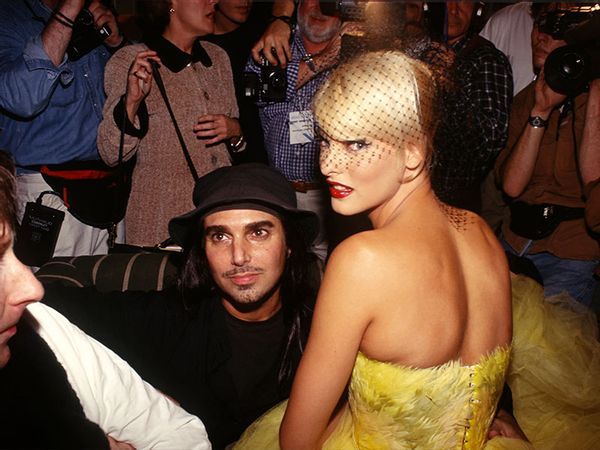 Steven Meisel and Linda Evangelista attend a Fashion Party during Paris Fashion Week in the 1990s in Paris, France. (Foc Kan/WireImage/Getty Images)
Steven Meisel and Linda Evangelista attend a Fashion Party during Paris Fashion Week in the 1990s in Paris, France. (Foc Kan/WireImage/Getty Images)Evangelista and Marie, the head of Elite Model Management, wed in 1987 when she was just 22 years old.
“I learned that maybe I was in the wrong relationship,” she said while reflecting on her marriage. The couple were together for six years before they divorced in 1993.
Evangelista continued, ”It’s easier said than done to leave an abusive relationship. I understand that concept, because I lived it. If it was just a matter of saying, ‘I want a divorce, see ya’… it doesn’t work that way.” She added that Marie “knew not to touch my face, not to touch the money-maker.”
Marie was accused of rape and sexual assault by several women during the 1980s and 1990s. He denied the allegations and eventually prosecutors closed the investigation earlier this year due to the statute of limitations.
“I would love for justice to be served. I would love for assholes like that to think twice and be afraid. I would love women to know they are not alone,” Evangelista said.
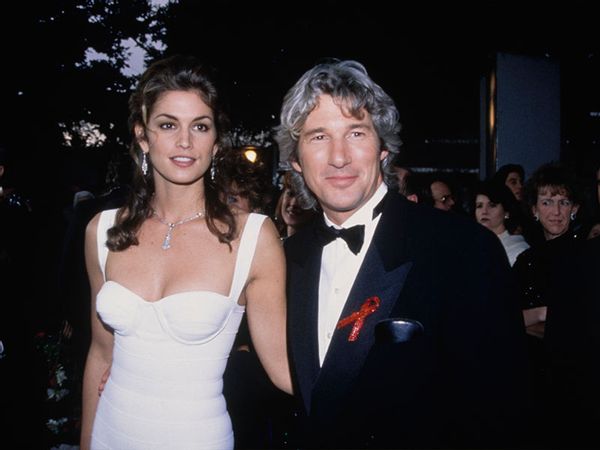 Cindy Crawford and Richard Gere during 65th Annual Academy Awards at Shrine Auditorium in Los Angeles, California, United States, 29th March 1993. (Vinnie Zuffante/Michael Ochs/Archives/Getty Images)
Cindy Crawford and Richard Gere during 65th Annual Academy Awards at Shrine Auditorium in Los Angeles, California, United States, 29th March 1993. (Vinnie Zuffante/Michael Ochs/Archives/Getty Images)“I think I was 22 when we met,” Crawford said of her early beginnings with Gere. “In the beginning of a relationship, when you’re a young woman, you’re like, ‘You like baseball? I like baseball. Oh, you’re really into Tibetan Buddhism? I might be into that. I’ll try that.'”
“You’re willing to kind of mold yourself around whoever you are in love with.”
Crawford was 25 when she tied the knot with the then-42-year-old Gere in 1991. They were together for four years before they parted ways in 1995. She added that her relationship with Gere took place during a “time in my career when I veered away from the high fashion elite and took more control.” In 1992, Crawford starred in the iconic Pepsi Super Bowl commercial, which catapulted her into stardom.
In the documentary, Crawford also looked back on the couple’s 1991 Oscars appearance. Crawford wore a red Versace gown with a low neck and high leg slit.
“I got invited to go to the Oscars with Richard. I’m like, ‘Well, what do models do well? We wear clothes well,” she said. “I mean, I better look good.”
“That was kind of what my thinking was, like, ‘I’m gonna go to the Oscars, I better be a freakin’ supermodel,'” she said.
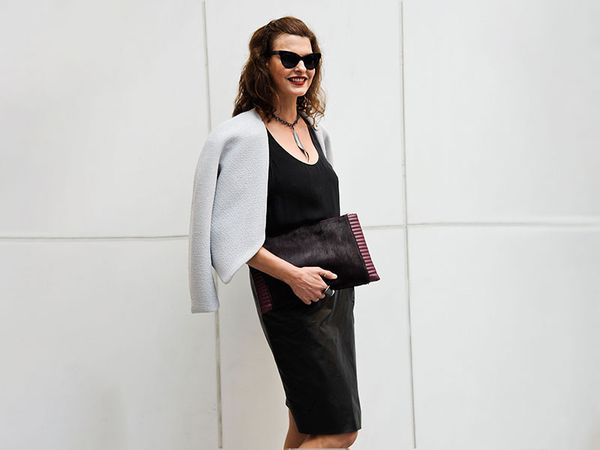 Linda Evangelista is seen outside the Proenza Schouler show on September 11, 2013 in New York City. (Daniel Zuchnik/Getty Images)
Linda Evangelista is seen outside the Proenza Schouler show on September 11, 2013 in New York City. (Daniel Zuchnik/Getty Images)Evangelista said she sought out the cosmetic treatment CoolSculpting, which removes fat by freezing it in a non-invasive manner, to help maintain her looks. The procedure, however, left her with a rare complication called paradoxical adipose hyperplasia, or overgrowth of fatty tissue.
“The commercials said I would like myself better. But what happened to my body after CoolSculpting became my nightmare,” Evangelista said. “I can’t like myself with these hard masses and protrusions sticking out of my body. I just can’t.
“That is what has thrown me into this deep depression that I’m in,” she continued. “It’s like a trap. It’s been years since I worked and years of hiding. I never went out the door unless it was maybe a doctor’s appointment that I had to go to.”
Evangelista also opened up about being diagnosed with breast cancer and undergoing a double mastectomy, only to be diagnosed with cancer a second time.
“I can celebrate a scar — but to be disfigured is not a trophy. I can’t see how anyone would want to dress me,” she said tearfully. “I can’t. I can’t. Now, to lose my job that I loved so much and lose my livelihood. My heart is broken. I loved my job.”
“The Super Models” is currently available for streaming on Apple TV+. Watch a trailer for it below, via YouTube:
Read more
about supermodels:

